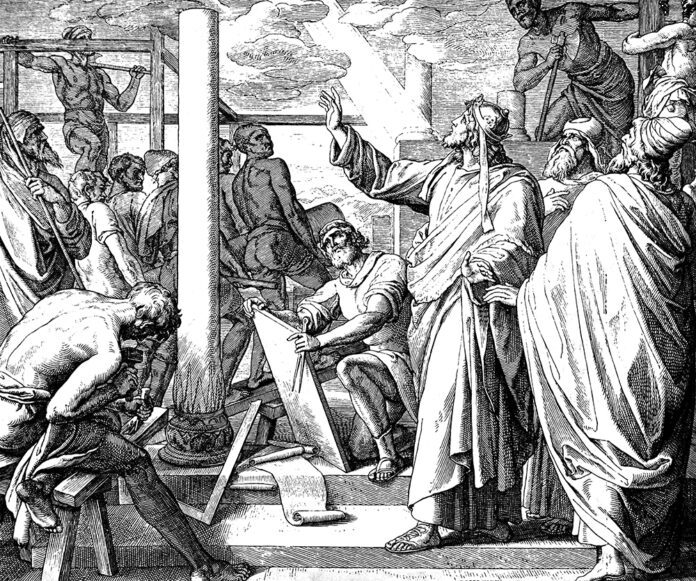Even though David’s kingship was not without hardships, He was considered the greatest king of Israel because of his unwavering love for God. After his forty years as king, he died and handed the throne to his son Solomon (not without contention). Initially following in his father’s footsteps in his love for God, Solomon is best known for his wisdom and building the Temple for God.
At the beginning of His reign, Solomon frequented Gibeon where he would sacrifice to the Lord. One night during one of these visits, God appeared to Solomon in a dream, offering him anything he wanted. Solomon, recognizing what God had done for his father David, humbly asks for the wisdom to govern the people of God well. God was pleased that Solomon did not ask for earthly pleasures and promised the wisdom for Solomon. In addition, He generously gives Solomon wealth and a long life if he stays true to God.
Solomon then begins the task of building a temple for the Lord. His father David had desired to build a house for the Lord, but God had refused because of the bloodshed and warfare that he had waged on Israel’s enemies. Rather, God promised David a great house that would always sit on the throne of Israel. Yet, at the end of his kingship, David had stored up money and materials and designated a spot to build the temple. Once Solomon became king, he began the work of mining precious stones and cutting down the cedars of Lebanon and bringing them back to Jerusalem. He then took seven years to build the temple. To do this, he conscripted forced labor from the people.
Once finished, the temple was magnificent. Inlaid with gold, precious stones, and ornate wood, no expense was spared for the house of the God of Israel. It consisted of three parts: the outer courtyard, the inner courtyard, and the holy place. The outer courtyard was a gathering place for the nations. The inner courtyard was for all who wished to sacrifice to the Lord. In it was a huge bronze altar where the Israelites or foreigners would bring their offering. The priests, after going through the proper rituals, would offer the sacrifice on behalf of the people.
Unlike the previous two courtyards, the holy place was completely enclosed. Divided into two sections by a beautiful veil, embroidered with cherubim, the front of the holy place was lit by lampstands which constantly burned. There was also an altar of incense that represented the prayers of the people constantly rising up to God. Finally, the bread of presence was kept here to show that God dwelt in the holy place. Only priests were allowed in this chamber of the holy place. Behind the veil was the Holy of Holies. This room was the resting place of the Ark of the Covenant and the mercy seat of God. The room also held two statues of gigantic cherubim who’s wings spread from wall to wall evoking the image of returning to the Garden of Eden. Only the high priest was allowed in the Holy of Holies, and he was only allowed once a year, on the Day of Atonement.
When the temple had been completed, Solomon dedicated the temple to God in front of all the people of Israel. He praised God for His faithfulness and implored the Lord for His forgiveness if ever the Israelites were to turn away from Him. Countless offerings were sacrificed and a weeklong feast was celebrated for the institution of the house of God where His glory cloud rested with the people of Israel. It became a place where the priests and people of God worshiped day and night.
The Temple was a sign that God was present with His people. It was reminiscent of the returning to the paradise of the Garden of Eden where God walked with Adam. The priests of Israel were charged with offering sacrifice, singing psalms of praise, and maintenance of the Temple recalling Adam in his task of tending the Garden. In addition, they oversaw the liturgical worship of Israel. Their office was one of mediation between God and his people.
The Temple is also a clear foreshadowing of Jesus. He is God’s presence here on Earth among us. He is the Word of God made flesh. Jesus calls himself greater than the Temple, and John tells us that Jesus refers to His Body as the temple that will be torn down and rebuilt in three days. Jesus takes on the role of both Temple and High Priest by being the presence of God in His divinity, and mediator of God to us in His humanity. He becomes the temple sacrifice in His sacrifice as the Lamb of God slain for our sins on the cross. In Jesus, the act of worship to God at the temple is wrapped up in His Life, and we are offered a share in this life by entering into His body, the Church, through Baptism and the Eucharist.
As long as the kings and people of Israel stayed faithful to God, He would remain with them forever in the temple. God would bless Israel, and they would be a light to the nations. However, as time goes on, Solomon falls to the temptations of wealth and pleasure. As a result, there will be devastating consequences for both Solomon and the future generations of Israel.






